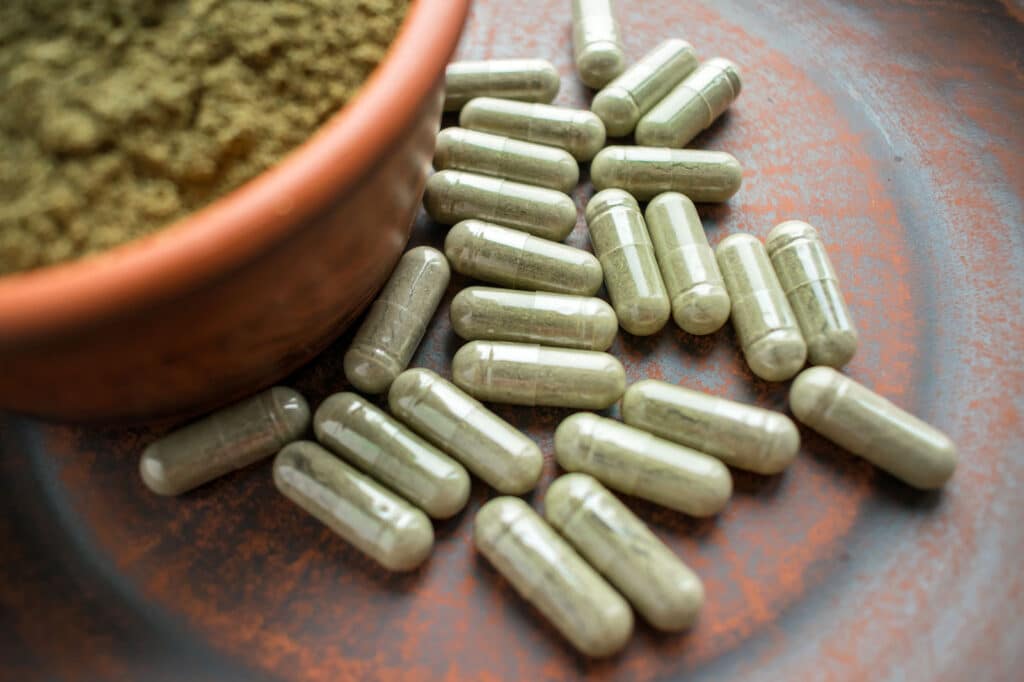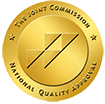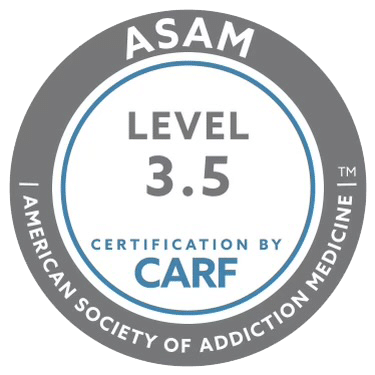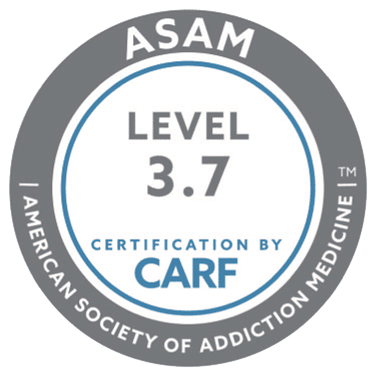Touted for its energy boosting, pain relieving, and mood enhancing effects, Kratom has garnered widespread attention as a natural remedy for various ailments.

It’s easily accessible in online “health” stores, smoke shops, and even farmer’s markets, so obtaining a bottle or two is as easy as ordering a pair of shoes.
However, what some people don’t realize is that kratom is almost as addictive as traditional opioids like morphine and heroin. It also has similar potentially negative and even deadly consequences when taken in large doses.
This article discusses everything you need to know about kratom, including what it is, how kratom addiction looks like, and options for kratom addiction treatment.
What Is Kratom?
Kratom (scientific name: Mitragyna speciosa) is a species of tropical evergreen tree Native to Southeast Asia, specifically in Cambodia, Thailand, Indonesia, and Malaysia. It belongs to the family Rubiaceae, which includes plants like coffee, gardenia, gallium, and noni.
Kratom is available in various forms, including dried leaves, powder, capsules, and extracts. Fresh and dried leaves are chewed, while powdered variants are ingested as a tea.
In recent years, kratom has gained notoriety for its stimulating and sedative effects. According to research, it has similar pain-relieving effects to opioid drugs like morphine and heroin.
Kratom leaves contain mitragynine and 7-hydroxymitragynine, psychoactive ingredients that interact with opioid receptors in the brain.
These ingredients produce energizing (stimulant) effects similar to that of caffeine. At high doses, they can induce pain-relieving and sedative effects, leading to feelings of relaxation and euphoria.
Is Kratom Legal In the US?
Due to its addictive properties, Kratom is banned in six states (Alabama, Arkansas, Indiana, Vermont, Rhode Island, and Wisconsin) and heavily regulated in the rest.
Despite being used medicinally in some areas of the world, the Food and Drug Administration (FDA) have yet to find evidence of its therapeutic benefits.
Its medicinal value is also disputed by some medical professionals, who cite concerns about its potential for addiction, abuse, and adverse health effects.
So while it isn’t illegal in the strictest sense of the word, it still carries substantial risks and therefore shouldn’t be purchased without careful consideration.
What Are the Side Effects of Kratom?
Researchers who have studied kratom found the risks associated with its use outweigh any perceived therapeutic or medicinal value it’s believed to have.
Common side effects of kratom overdose include:
- Vomiting
- Nausea
- Sweating
- Itching
- Chills
- Abnormal weight loss
- Constipation
- Muscle pain
- Skin darkening
Long-term use of kratom can result in more serious side effects such hallucinations or delusions, liver damage, and seizures.
The National Institute on Drug Abuse have reported instances of gastrointestinal, cardiovascular, and respiratory problems connected to kratom intake.
When taken with prescription medicines, kratom causes users to experience severe headache, difficulty communicating, and confusion.
Kratom use during pregnancy hasn’t been well documented, but the active compounds in kratom can adversely affect infant development.
It’s also associated with increased blood pressure, tachycardia, and sedation, which could pose risks to both the mother and the developing fetus.
Common Names of Kratom
Kratom is primarily sold as a botanical product or dietary supplement rather than a pharmaceutical medication, so it doesn’t have standardized brand names like prescription drugs. However, it has various “street” names like:
- Biak-biak
- Ketum
- Thang
- Kakuam
- Ithang
- Thom
- Mambog
What Are the Common Signs and Symptoms of Kratom Abuse?
Kratom is a quick-acting, long-lasting substance.
People who take kratom in small doses may appear unusually energetic, nervous, or talkative. In high doses, they may appear lethargic and insensitive to pain.
These effects can vary depending on factors such as the individual’s tolerance, body chemistry, and the drug’s strain and dosage.
Kratom abuse shares many similarities to alcoholism and stimulant abuse. Signs of addiction include:
- Wanting to use kratom on a regular basis, even up to several times a day
- Needing increasingly higher doses to achieve the desired effects
- Experiencing physical and psychological symptoms when attempting to stop or reduce kratom (withdrawal)
- Using kratom despite negative consequences, such as relationship problems, financial difficulties, or legal issues
- Unable to control or limit kratom use, despite efforts to do so
- Neglecting work, school, or family responsibilities in favor of using kratom
- Spending large amounts of money on the drug, even when money is tight
- Resorting to risky behavior to get the substance, such as violence, stealing, and maxing out credit cards
How to Recognize Kratom Addiction In Others
People who suffer from kratom addiction may try to hide their symptoms from you, so it can be difficult to determine whether they’re struggling with addiction or something else.
However, there are some tell-tale signs to look out for, such as:
- Changes in appearance or physical health, such as weight loss or weight gain, red eyes, or frequent illnesses
- Changes in mood, such as depression, irritation, anxiety, and physical discomfort
- Financial distress, such as borrowing money frequently, selling personal belongings, or struggling to pay bills
- Decline in school or work performance
- Skipping school or work on a regular basis
- Neglect of household duties and personal hygiene
- Secretive and isolating behavior
Common Withdrawal Symptoms of Kratom
Withdrawal symptoms associated with kratom addiction can range from mild discomfort to severe distress. Symptoms typically begin within 12 to 24 hours after the last dose.
- Intense cravings
- Irritability and restlessness
- Anxiety
- Aggression and emotional outbursts
- Insomnia
- Loss of appetite
- Tremors
- Fever
- Itchiness
- Dry mouth
- Rapid heartbeat
Kratom withdrawal symptoms can be particularly challenging for individuals with underlying health conditions, those who have co-occurring substance use disorders, and those who attempt to quit abruptly without medical supervision.
While kratom withdrawal alone rarely leads to death, complications arising from severe withdrawal symptoms isn’t uncommon.
Therefore, if you or a loved one want to stop using kratom, do so under the guidance of a healthcare professional or, at the very least, contact a drug abuse helpline.
The Substance Abuse and Mental Health Administration (SAMSA) has a national helpline that provides free, confidential and referral services for people dealing with substance abuse. This helpline is available 24/7 and offers assistance in both English and Spanish.
You can contact them at 1-800-662-HELP (4357) or TTY 1-800-487-4889.
Treatment Options for Kratom Addiction
It’s important to recognize that kratom addiction—and any form of addiction, for that matter—alters the structure and chemistry of the brain, making it near impossible to quit cold turkey. Luckily, help is available.
Here are some of the treatment options for kratom addiction:
Detox
Medically-assisted detox is the most common form of addiction treatment. It involves gradually tapering the use of the substance to minimize withdrawal symptoms.
The goal of medically-assisted detox is to safely remove the addictive substance from the body while providing comprehensive medical care and support.
In addition to medication management, it often includes nutritional support, hydration therapy, and emotional care.
Medically-Assisted Therapy
Unlike medically-assisted detox, which focuses on safely removing the addictive substance from the body, medically-assisted therapy involves ongoing treatment from substance use.
It doesn’t follow the traditional taper method and instead uses alternative medications to manage withdrawal symptoms.
Examples of such medications include:
- Dihydrocodeine
- lofexidine
- Methadone
- Buprenorphine
- Naltrexone
- Acamprosate
- Disulfiram
Some doctors may also prescribe anti-inflammatories or antidepressants, especially in cases where the patient is suffering from mental health conditions.
Antidepressants may help address underlying neurobiological imbalances associated with kratom addiction, while anti-inflammatories alleviate physical discomfort during recovery.
Behavioral Therapy
People suffering from kratom addiction benefit from behavioral therapies like cognitive-behavioral therapy (CBT) and dialectical behavior therapy (DBT).
CBT is a structured, goal-focused treatment option that teaches people to have more control over their actions and thought patterns. It offers coping skills to manage cravings, identify triggers, and challenge distorted thinking patterns associated with addiction.
Meanwhile, DBT helps people build skills in emotional regulation, distress tolerance, and interpersonal relationships.
CTB sessions usually last for only a few weeks, but DBT lasts more than a few months.
People with severe kratom addiction can benefit from both, especially if they’re suffering from co-occurring mental health disorders.
Peer Support Groups
Alongside detox, medications, and behavioral therapy, people who want to recover from kratom addiction greatly benefit from peer support groups.
Peer support groups not only help in recovery but also provide a sense of belonging, acceptance, and understanding for individuals facing similar challenges.
Seeing others who have successfully overcome addiction can instill hope in individuals struggling with kratom addiction. They’ll realize that despite potential setbacks, sobriety remains a possible and achievable goal.
In the US, most peer support groups are free. They’re run by volunteers and trained peers. You can find your nearest peer support group on the Mental Health American Affiliate website.
If you’re unable to physically join support groups, online peer-to-peer communities are available.
Final Thoughts
Native to Southeast Asia, Kratom is a plant that mimics the effects of opioid drugs like morphine and heroin. It produces stimulant effects in low doses and sedative effects in high doses.
Kratom is banned in six states in the US and regulated in the rest. The FDA hasn’t approved kratom for any medical use due to concerns about its safety and efficacy.
If you or a loved one is suffering from kratom addiction, treatment is available.
Treatment options include detox, medication, and behavioral therapy, among others.







